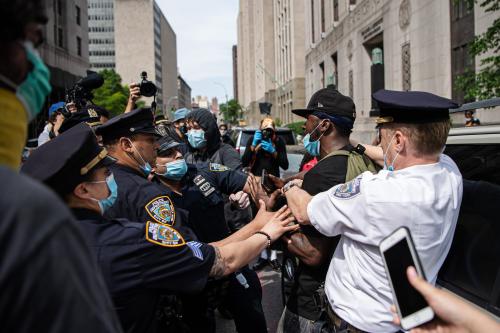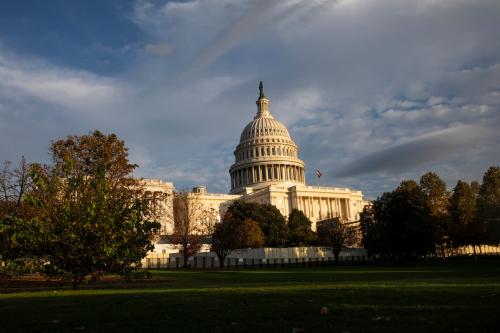George Floyd’s death has galvanized much of America to move the needle toward police reform ideas—such as defunding police—that were previously viewed as radical.
“Defund the police” means reallocating or redirecting funding away from the police department to other government agencies funded by the local municipality. That’s it. It’s that simple. Defund does not mean abolish policing. And, even some who say abolish, do not necessarily mean to do away with law enforcement altogether. Rather, they want to see the rotten trees of policing chopped down and fresh roots replanted anew. Camden, New Jersey, is a good example. Nearly a decade ago, Camden disbanded (abolished) its police force and dissolved the local police union. This approach seems to be what Minneapolis will do in some form, though the nuances are important.
Different from abolishing and starting anew, defunding police highlights fiscal responsibility, advocates for a market-driven approach to taxpayer money, and has some potential benefits that will reduce police violence and crime. Below, I outline some of the main arguments for defunding the police.
Calls for service
Data show that 9 out of 10 calls for service are for nonviolent encounters. Now, this does not mean that an incident will not turn violent, but police at times contribute to the escalation of violent force. Police officers’ skillset and training are often out of sync with the social interactions that they have. Police officers are mostly trained in use-of-force tactics and worst-case scenarios to reduce potential threats. However, most of their interactions with civilians start with a conversation.
Advocates for the defund movement like Phillip McHarris and Thenjiwe McHarris argue that shifting funding to social services that can improve things such as mental health, addiction, and homelessness is a better use of taxpayer money. This approach further enhances the push to decriminalize and destigmatize people with mental health conditions and addiction problems. Ever since the overcriminalization of people addicted to crack cocaine in the 1990s, some scholars, practitioners, and policymakers have said that this shift is long overdue.
Additionally, the research I have conducted with hundreds of police officers show that they respond to everything from potholes in the street to cats stuck up a tree. Police officers are also increasingly asked to complete paperwork and online forms. Obviously, documentation is important and desperately needed. The overwhelmingly blank report in the killing of Breonna Taylor in Louisville that listed her injuries as “none” highlights the importance of documentation. It could be argued, however, that reducing officer workload would increase the likelihood of solving violent crimes. Police officers are overworked and overstressed. Focusing on menial tasks throughout the day is inefficient and a waste of taxpayer money. Other government actors should be responsible for these and receive adequate funding for doing them.
Homicide clearance rate
Police officers are not as successful as people think at solving violent crime. My Brookings colleagues Andre Perry, David Harshbarger, Carl Romer, and Kristian Thymianos argue that “the failure to prosecute murderous police typifies a bad overall track record with solving violent crimes: Approximately 38% of murders, 66% of rapes, 70% of robberies, and 47% of aggravated assaults go uncleared every year.” Maybe in baseball or basketball these rates make a player an all-star, but the public expects police officers to be more successful at solving violent crime.
More importantly, police stops relative to charges and convictions are relatively low. To show how egregious this is, a study of the NYPD stop-and-frisk program found that well over 90% of people stopped by the police were not committing any crime and did not have any contraband or weapons on them. Overwhelmingly, the people stopped were Black and Latino, and physical force was used half the time. Interestingly, police were more successful at identifying criminality for whites versus Blacks. This is because officers use suspicious behavior when interacting with whites and use skin tone as the metric of suspicion when interacting with Black people. More police on the streets may be used to control the movement of Black bodies rather than solving crime. This is why the New York State Supreme Court ruled stop-and-frisk as unconstitutional. No-knock warrants and chokeholds should follow this pattern.
Education and work infrastructure
One consistent finding in the social science literature is that if we really want to reduce crime, education equity and the establishment of a work infrastructure is the best approach. A study using 60 years of data found that an increase in funding for police did not significantly relate to a decrease in crime. Throwing more police on the street to solve a structural problem is one of the reasons why people are protesting in the streets. Defunding police—reallocating funding away from police departments to other sectors of government—may be more beneficial for reducing crime and police violence.
What defunding looks like
In recent weeks, some large municipalities with a history of police brutality have reallocated funds in line with the defund police movement. Los Angeles will have at least $100 million reallocated away from LAPD to programs for minority communities. San Francisco Mayor London Breed said that she will work with community groups to reprioritize funding. Baltimore City Council voted to reallocate $22 million away from the police department’s fiscal budget for 2021, which is typically over $500 million. The city council plans to redirect the funding to recreational centers, trauma centers, and forgivable loans for Black-owned businesses. Prince George’s County, Maryland, aims to reallocate $20 million away from a new training facility for its police department (though the money will not come out of the police department’s budget) and to remove student resource officers from schools. Other areas, such as Minneapolis, have advocated for removing police officers from schools as well.
Altogether, it is clear that municipalities across the U.S. are making changes in line with the defund police movement. So, while the word “reallocate” may be a more palatable, digestible word on the House floor or at a city council meeting, “defund” surely gets more attention on a protest sign. And more importantly, it seems to be having an impact.
The Brookings Institution is committed to quality, independence, and impact.
We are supported by a diverse array of funders. In line with our values and policies, each Brookings publication represents the sole views of its author(s).







Commentary
What does ‘defund the police’ mean and does it have merit?
June 19, 2020